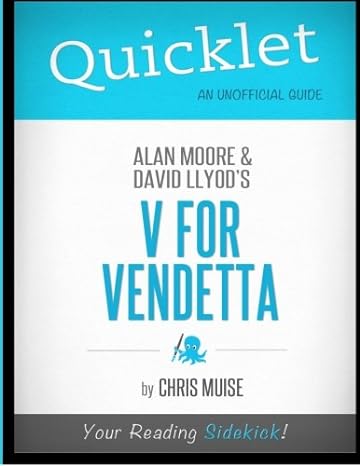Chris Muise, "Quicklet - V For Vendetta"
English | 2012 | ISBN: 161464084X | EPUB | pages: 78 | 1.1 mb
English | 2012 | ISBN: 161464084X | EPUB | pages: 78 | 1.1 mb
Quicklets: Learn more. Read less. V for Vendetta first graced the pages of the British comics anthology series, Warrior, in its flagship issue in 1981. The series continued there until 1985 when Warrior ceased publication. Left in limbo for three years, the series was eventually picked up again in 1988 by DC Comics, one of the worlds largest comic book companies, where the story was completed. Artist David Lloyd provides the art for the majority of the series, though artist Tony Weare contributed to a few issues. Originally in black and white, DC reprinted the original pages in watercolors, and continued to do so until the series came to fruition. One of Alan Moores first attempts to pen a continuing series, V for Vendetta helped put Moores name on the map. Moore wrote the series as a response to Thatcherism, the form of conservative government in power in the England at the time of the storys creation. The titles popularity lead to Moore becoming more prominent across the pond, which opened the doors for other British comic writers to find new popularity in North America, such as the likes of Grant Morrison and Neil Gaiman, among othersall titans of the industry in their own right. Today, the book enjoys a great deal of popularity and critical praise, especially in the wake of the 2006 film adaptation starring Hugo Weaving and Natalie Portman, which has earned over $132 million. It has also gone on to have a deeper significance, with protesters donning the Guy Fawkes mask popularized by the title character, especially in the Occupy Wall Street movement. BOOK EXCERPT From the introduction by Chris Muise: Verily,V For Vendetta Validates My Valuation Of Vivid Visual Vignettes! Ever since I was little, Ive loved comic books and the superheroes that populate their pages. Spider-Man, Batman, the X-Men; these were the first heroes I knew, and the heroes that would shape my interests for years to come, from comics specifically to storytelling and narrative in general. Of course, I grew up in the late 80s and early 90s, and while the stigma had tempered by my time, comics were largely considered to be a territory strictly for losers, for nerds, for kids. As it does for all of us, it came time for me to grow up but comics, my dear childhood treasures, I did not care to part with. While Spider-Man and his tights-donning cohorts still stayed with me, I yearned for something more, something with more substance. Surely, great minds had dabbled in the medium of comics, and created art. And indeed, I discovered, they had. Among titles such as Watchmen, Maus, and the Sandman series, V for Vendetta was one of the first comics I read meant for adults, and more so, meant to be art. I became familiar with it through the 2006 motion picture, but in actually reading the book, I was amazed at how intricate the narrative was. One cannot simply sit back and let V for Vendetta happen to you; it forces you to take an active role in your understanding in the material, else you be left in the dust. With the new-found popularity comics are enjoying today, I feel like the world discovered the true artistic value of comics as I did, and it became a thrilling time to live in. Granted, many of these titles existed before I was even born, but through perseverance, helped to lift the stigma that nothing of value lies in the funny pages. I hope you, dear reader, discover that as well, as you read this Quicklet. …To be continued! Quicklets: Learn more. Read less.
CHAPTER OUTLINE
- Introduction
- Verily,“V for Vendetta” Validates my Valuation of Vivid Visual Vignettes!
- Alan Moore: Comic Savant
- About “V For Vendetta”
- Overall Summary of “V for Vendetta” by Alan Moore
- …and much more
- …and much more



